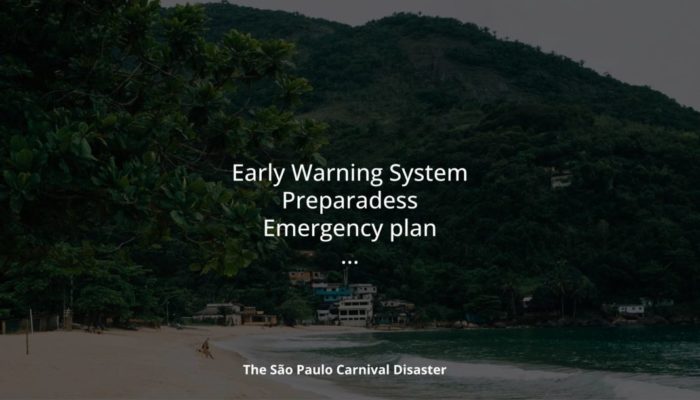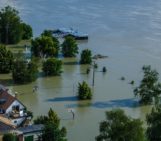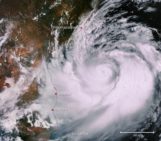
In February 2023, Brazil experienced its largest rainfall event on record, which devastated the northern coast of the state of São Paulo. This event caused landslides, floods, and numerous fatalities, making it even more tragic than previous disasters in the region, which already have been elaborated on in another blog post. The situation highlights the urgent need for effective emergency management plans, and early warning systems to tackle the increasing frequency and magnitude of extreme weather events due to climate change.
The worst-case scenario for a disaster to happen
The Northern Coast of the State of São Paulo is a highly desirable destination for its beautiful seaside resorts and picturesque beaches; it is bordered by the Serra do Mar mountain chain on one side and the sea on the other. This region is a popular destination, particularly among affluent individuals seeking to escape the hustle and bustle of urban life, especially during holidays. Conversely, the majority of the local inhabitants are socioeconomically disadvantaged and reside in regions that are susceptible to natural hazards. During the Carnival, this part of Brazil became crowded, and it was then that Brazil recorded its largest-ever rainfall event in 2023.
The recorded rainfall dumped 683 mm of water in just 9 hours in the municipality of São Sebastião, as well as the accumulated rainfall in 24 hours in the other cities of the region, 682 mm in Bertioga, 337 mm in Ilhabela, 335 mm in Ubatuba, and 234 mm in Caraguatatuba [1], causing several types of landslides and flooding. The consequences of the extreme rainfall event and associated phenomena were alarming and affected the entire region of the northern coast, with dozens of people dead and thousands homeless [2]. Many people were stranded for days because of landslides that blocked roads and floods that invaded houses. For example, a section of a highway disappeared, occupied by sediment deposits from the landslides [3].
Since 2020 Brazil has suffered from escalating extreme weather events, breaking records year after year [4, 5, 6] with over 11 disasters recorded so far. What was remarkable about the February 2023 event was the unprecedented amount of rain that fell in just 24 hours and the impact of the rainfall across the entire region along an axis spanning over 100 kilometres.
Negligence, or have we underestimated climate change projections?
Scientific communication is crucial to shed light on what is known and what is not. We know that climate projections for these areas o indicate an increase in extreme rainfall events [7], and consequently associated events such as floods and landslides would be amplified [8]. Since 2020, a continuous succession of exceptional precipitation occurrences led to the loss of life and economic damages, providing strong evidence for a clear rise in the frequency and intensity of such events.[6].
The rising number of consequences of natural hazards events highlights that the region needs an effective regional operational Early Warning System (EWS) as the one in Rio de Janeiro [9]. Furthermore, the fatalities of this event underscore the need for a people-centred evacuation plan in order to move them in time from critical areas. [10]. Additionally, the magnitude of this event affected areas of all levels of susceptibility to landslides and floods. This event highlighted the need to do more than an EWS, especially for preparedness and adaptation to face events highly prone to triggering disasters, as it is now not only the poorest layers of society who are at risk.
Since projections indicate the worsening of events that have already occurred in the past, it is essential to consider this factor when making decisions or developing emergency preparedness and response plans. Therefore, it is necessary to first assume that extreme rainfall events are indeed more frequent and severe. National Centre for Monitoring and Alerts of Natural Disasters (CEMADEN) points out that 8 million Brazilians live in areas at risk of landslides and floods [11], and only by working together with the population can we involve everyone in the effort to face these new conditions, as recommended by the Sendai Framework for Disaster Risk Reduction [12].
And what do we expect for the future?
As mentioned in the post on disasters in Brazil in 2020, the consequences of the economic crisis in Brazil aggravated by the pandemic of covid-19, tend to push even more people into situations of disaster exposure. On the contrary, civil defence agencies have received less funding [13], delaying an essential step to prevent loss of life. However, according to the Ministry of Environment, they will be implementing new measures to prevent disasters like this from happening again. These actions will include creating effective warning systems, developing escape routes, and promoting a culture of alertness among the population. They emphasised the importance of planning ahead and taking action before emergencies occur [14].
References
[1] CEMADEN (2020). Mapa interativo: download de dados de estações pluviométricas. Available at: http://www.cemaden.gov.br/mapainterativo/
[2] – 2023 São Paulo, Brazil Floods. Available at: https://disasterphilanthropy.org/disasters/2023-sao-paulo-brazil-floods/
[3] DW (2023) – Brazil: Cities cancel Carnival due to deadly floods. Available at: https://www.dw.com/en/brazil-cities-cancel-carnival-due-to-deadly-floods/a-64759606
[4] Globo (2022) – Brasil registrou recorde de eventos extremos de chuva em dezembro de 2022. Available at: https://revistagalileu.globo.com/Ciencia/Meio-Ambiente/noticia/2022/01/brasil-registrou-recorde-de-eventos-extremos-de-chuva-em-dezembro-de-2021.html
[5] BBC (2022) – Mortes por chuvas em 2022 já superam ano passado inteiro. Available at: https://www.bbc.com/portuguese/brasil-61651974
[6] G1 (2023) – Tempestades no Brasil ficaram muito mais fortes e frequentes nos últimos dois anos. Available at: https://g1.globo.com/jornal-nacional/noticia/2023/02/21/tempestades-no-brasil-ficaram-muito-mais-fortes-e-frequentes-nos-ultimos-dois-anos.ghtml
[7] IPCC, 2022: Climate Change 2022: Impacts, Adaptation, and Vulnerability. Contribution of Working Group II to the Sixth Assessment Report of the Intergovernmental Panel on Climate Change [H.-O. Pörtner, D.C. Roberts, M. Tignor, E.S. Poloczanska, K. Mintenbeck, A. Alegría, M. Craig, S. Langsdorf, S. Löschke, V. Möller, A. Okem, B. Rama (eds.)]. Cambridge University Press. Cambridge University Press, Cambridge, UK and New York, NY, USA, 3056 pp., doi:10.1017/9781009325844
[8] Gariano, S.L., and Guzzetti, F. (2016). Landslides in a changing climate. Earth-Science Reviews 162, 227–252. https://doi.org/10.1016/j.earscirev.2016.08.011
[9] Fausto Guzzetti, Stefano Luigi Gariano, Silvia Peruccacci, Maria Teresa Brunetti, Ivan Marchesini, Mauro Rossi, Massimo Melillo, Geographical landslide early warning systems, Earth-Science Reviews, Volume 200, 2020, 102973, ISSN 0012-8252, https://doi.org/10.1016/j.earscirev.2019.102973.
[10] Folha de São Paulo (2023) – Governo de SP foi alertado de risco de desastre 48 h antes. Available at: https://www1.folha.uol.com.br/cotidiano/2023/02/governo-de-sp-foi-alertado-de-risco-de-desastre-no-sahy-48-horas-antes-diz-centro-de-monitoramento.shtml
[11] Globo (2023) – Mais de 8 milhões vivem em áreas de risco, diz Cemaden. Available at: https://valor.globo.com/brasil/noticia/2023/02/23/mais-de-8-milhoes-vivem-em-areas-de-risco-diz-cemaden.ghtml
[12] UNDRR (2015) Sendai Framework for Disaster Risk Reduction 2015 – 2030. United Nations 37
[13] UOL (2023) – Ministro: Governo Bolsonaro destinou só R$ 25 mil para desastres em 2023. Available at: https://noticias.uol.com.br/cotidiano/ultimas-noticias/2023/02/21/ministro-governo-bolsonaro-destinou-so-r-25-mil-para-desastres-em-2023.htm
[14] G1 (2023) – ‘Eventos climáticos extremos já são realidade’, diz Marina em visita a área devastada no Litoral de SP. Available at: https://g1.globo.com/sp/vale-do-paraiba-regiao/noticia/2023/02/22/eventos-climaticos-extremos-ja-sao-realidade-diz-marina-em-visita-a-area-devastada-no-litoral-norte-de-sp.ghtml
Post edited by Joana Parente, Soheil Mohammadi and Asimina Voskaki




